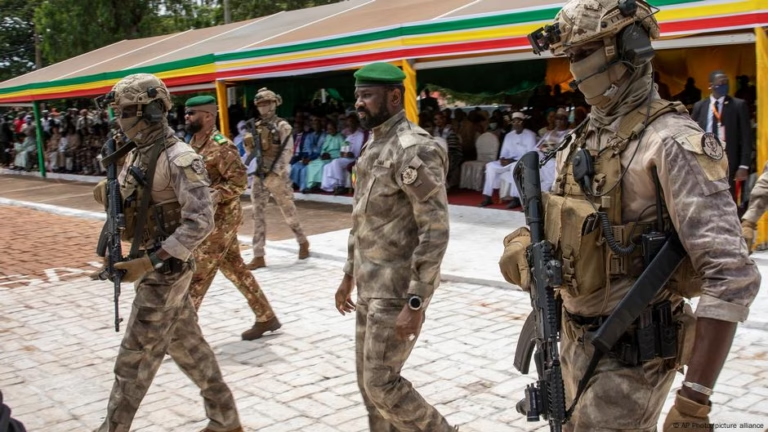Infrastructure
The Bundeswehr is the owner of around 1,500 properties across Germany, but many of these are in a “catastrophic condition,” according to Eva Högl, the Parliamentary Commissioner for the Armed Forces, in her annual report for 2024.
For example, the Südpfalz barracks in Germersheim had mold in the soldiers’ quarters, with “water damage and plaster falling off the walls everywhere,” she said following a visit there. It is estimated that renovating all barracks in the country would require approximately €67 billion ($72 billion).
Personnel
Personnel shortage is one of the biggest concerns for the German military. It currently has around 182,000 soldiers. The Defense Ministry’s goal is to have 203,000 soldiers, but recruiting has been a problem.
Although the number of applications increased significantly in 2024, one in four new recruits left the Bundeswehr within the first six months.
The reintroduction of compulsory military service, which was suspended in 2011, is also being considered, but this would entail significant costs as the Bundeswehr lacks sufficient infrastructure for housing and training conscripts.
Weapons systems
Some of the Bundeswehr’s equipment is outdated. After the Cold War, only essentials were procured, and much equipment was simply patched up until spare parts ran out.
This changed when the Bundeswehr was given a special fund of €100 billion following the Russian invasion of Ukraine in 2022. This money is being used to fill the gaps, but the Bundeswehr is still far from being fully equipped.
The Luftwaffe is currently receiving 35 F-35 fighter jets from US manufacturer Lockheed Martin to replace the Tornado fighter jets from the 1980s. This will cost more than €8.5 billion. The government is also in talks to buy 60 new Boeing CH-47 heavy transport helicopters.
The navy is set to receive additional frigates, submarines, and P8 Poseidon maritime reconnaissance aircraft, and the army will introduce the world’s most modern main battle tank, the Leopard 2A8, this summer. The old Marder infantry fighting vehicle will be replaced by the modern Puma.
There is also an urgent need for action in air defense — an area where the Bundeswehr has severely fallen behind in the past. A combination of several interception systems, including Patriot and IRIS-T, is set to protect Germany from air attacks in the future.
While some of the equipment has already been delivered, the Bundeswehr will have to wait years for everything to arrive.
“It will take seven to eight years for submarines, six years for frigates, 2.5 years for tanks and the same for self-propelled howitzers,” Defense Minister Boris Pistorius said recently.
Combat drones
The Bundeswehr operates several different reconnaissance drones. Its five Heron TP drones, which are the size of a small aircraft, can be armed.
However, the Bundeswehr lacks combat drones, as there are no guidelines and rules for their use. Drone technology is rapidly evolving. Planning and procurement processes in the Bundeswehr are painfully slow and often take several years.
The Bundeswehr also lacks effective defense systems against drone attacks. Espionage drones have recently been spotted over Bundeswehr bases, making this matter particularly urgent.
Ammunition
The Bundeswehr has only a relatively small stock of ammunition. After the Cold War, stocks were reduced and production capacities cut. Furthermore, the Bundeswehr has transferred a large part of its stock to Ukraine in recent years, including 427,000 rounds of artillery ammunition in the standard 155-millimeter caliber.
The Ukrainian army consumes huge amounts of ammunition on the battlefield, and the German military now wants to stockpile more for itself. It has ordered artillery ammunition worth approximately €8.5 billion from the arms manufacturer Rheinmetall.
This is the largest order in the company’s history. While the German arms industry is trying to increase its production capacities, it cannot do so overnight.
Digital transformation
The Bundeswehr is also lagging behind when it comes to digitalization. Many officers still fill out printed forms, and cyber defense urgently needs strengthening. In 2024, the Cyber and Information Space Command (CIR) was upgraded to a fourth branch of the armed forces, alongside the army, air force, and navy.
“Hybrid attacks are a reality, every day,” Bundeswehr Inspector General Carsten Breuer warned recently. Part of the additional billions will therefore go toward digitalization, including AI applications, new data centers, and secure satellite communication.
Lithuania brigade
One of Defense Minister Pistorius’ most ambitious projects is to set up a Bundeswehr brigade in Lithuania. Almost 5,000 German soldiers are to be permanently deployed to the Baltic country by 2027, in order to strengthen NATO’s eastern flank. This mission is unprecedented for the Bundeswehr. The extra billions will secure this deployment and other German commitments in NATO.
This article was originally written in German.
While you’re here: Every Tuesday, DW editors round up what is happening in German politics and society. You can sign up here for the weekly email newsletter Berlin Briefing.








